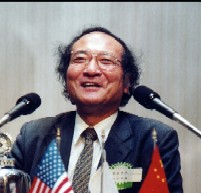Commodore Perry's arrival and Yokohama's debut on the world stage
June 9th,2004
Caretaker of the Yokohama Kurobune Study Group
Mr.Hisao Haneda��
 Commodore Perry first landed at Uraga on June 14 1853. He anchored offshore Uraga on July 8, then stayed in Tokyo Bay, his time here being only 9 days.
Commodore Perry first landed at Uraga on June 14 1853. He anchored offshore Uraga on July 8, then stayed in Tokyo Bay, his time here being only 9 days.
He then repeated his visit on March 8, 1854 and landed in Yokohama.
Commodore Perry was able to sign a peace and friendly pact with the Japanese on March 31, and this started an era of dramatic change for Japan.
When Commodore Perry left Tokyo Bay, the Shogunate called for fortifications to be built to protect the bay, and my grandfather was also made to offer his services.
When Commodore Perry landed, Yokohama was a hamlet of 78 dwellings and a thousand people. Today Yokohama has a population of 3.5 million, but according to a map created by Tadataka Inoh 50 years before Perry��s landing the city area today has increased several hundred times, and the change is great.
There are many reasons for Perry��s visit. 1. Finding a base to load coal for American vessels going to China 2. Finding a base to replenish food and water for the American whaling fleet 3. To explore markets in Asia outside of China 4. For the U.S. Navy to maintain its strength against domestic pressures for size reduction.
For the first visit, the flagship was the Susquehanna, which together with the Mississippi were engine driven battleships, and then the Plymouth and Saratoga which were sailing battleships. At the time, the largest British man-of-war was a thousand tons, the American whaling vessels 300 tons, and the Japanese vessels were of a maximum of 100 tons plying domestic routes. Therefore, the Perry fleet was the largest and strongest in the world then.
Although Perry is misunderstood that he forcibly entered the country, his mission was actually to enter Japan without use of force to present a letter from the American President to the proper channels to reach the Shogunate.
President Fillmore instructed Commodore Perry not to use force unless it was needed for self-defense.
Commodore Perry landed at Uraga on July 14 with 300 of his crew, and presented President Fillmore��s letter to the Japanese representative, the Governor of Uraga, and left saying that he would return.
Immediately, the Shogunate started to fortify Tokyo Bay, and called in military forces from outlying areas to defend the area. The influx of the military and fortification laborers caused an inflation to arise in Edo (Tokyo).
Perry arrived and landed at Yokohama village on March 8, on the site where are Port Opening Archives are located today. The results were reported to the public by the daily newspapers. Japan was a closed society at the time, and wherever foreign envoys appeared, they were said to be delivering tribute, so Perry��s visit was reported a delivering tribute as a gesture to open the country.
Perry brought many gifts, but the one that caught the interest of the Japanese was a scale model steam locomotive.
The Japanese in exchange also gave gifts. It is said that the Shogunate budgeted 2,000 ryo to host Perry��s party. This sum today is to be equivalent to 150 million yen (US$1.35 million).
Many portraits of Perry were made and distributed, but as no artist had actually seen him, they were all imaginary and serve to tell us what they imagined foreigners to look like in those days.
On June 19, 1858, the formal Friendship Pact was signed, and the Shogunate designated Yokohama to be the open port. Until then, Japan had been steadfast in her closed door policy, but now she was forced to open her doors. This impact together with others caused the collapse of the Shogunate in 1868 and the installation of the Meiji Government. In the interim of 14 years, the world had changed, and Yokohama had become the originating center for a fusion of Japanese and Western civilizations.